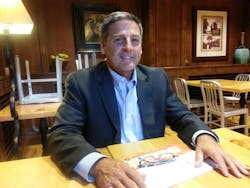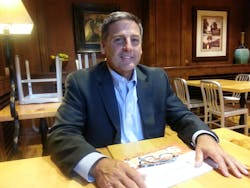Even Steve Jobs Stepped in Excrement on his Way to Excellence
Usually, event managers invite big-name keynote speakers for their drawing power. And usually these speakers haven’t a clue what their audience does. But on this, the second day of Dematic’s annual user conference in Park City, Utah, I heard two keynoters who were cheerleaders for what their audience does. They actually connected the dots between economic success and the attendees’ occupations.
First up was Marci Rosell, PH.D, former chief economist for CNBC and financial journalist. She made the point that the U.S. has been in full recovery mode for two years now, but many still think we’re in a recession because the recovery hasn’t created a lot of jobs. Why? Because it’s been an export driven recovery, driven by transportation.
“The biggest changes to an economy come from innovations in transportation,” she said. “It frees all of us from having to be farmers and raising our own food. It helps us distribute goods to those who need them and makes them better off. But average Americans have no idea you guys exist, that you are an enormous powerhouse of creation. All they have in mind is the decline of manufacturing. Manufacturing went through the same process of development that agriculture went through, from labor intensive to capital intensive because of innovation and your industry is the same way. It’s about manufacturing becoming more productive.”
In other words, work smarter, not harder, which mirrored the theme of Dematic’s event: “Get Smart.”
Guy Kawasaki continued that theme in his luncheon speech. He is the former chief evangelist of Apple and co-founder of Alltop.com. With that background, he put the nature of productivity-through-technology in the proper light, using Apple as an example—a company where Steve Jobs put every innovator who worked for him through a smell test, starting with the question, “Why should your innovation exist?”
“When Steve Jobs created a new computer he did not create a slightly better Apple II, he created Macintosh,” Kawasaki said. “He didn’t create a slightly better Walkman, he created an mp3 player. Great products are about the customer interface. They need to be deep, intelligent, empowering and elegant.”
And in getting there, he added, they may have to go through a stage of crappiness.
“The first permutation of a great product can have elements of crappiness to it,” he said. “The first laser writer was crap, but much better than the daisy wheel printer. As long as you jump a curve with the innovation, it’s OK for your first permutation to have elements of crappiness to it. If you wait for the perfect world the world will pass you by. I’m not saying ship crap, I’m saying ship revolutions that meay have elements of crappiness.”
That’s where the voice of the customer comes in—to detect the faults and make the product better in ways you may never have anticipated.
“Don’t freak out when that happens, take the money,” he advised. “With Apple we thought we had a word processing machine. But desktop publishing happened and that made Macintosh successful. If it weren’t for Aldus Pagemaker there would be no Apple today.”
After these presentations I had the chance to sit down with the host of this conference, John Baysore, Dematic North America CEO (shown below), to discuss what he took from them in light of his own company’s innovations in material handling and logistics. He addressed opportunities for his and other companies to “jump the curve,” as Kawasaki put it, in response to what customers told him they want.“A common theme among customers is order accuracy because of e-commerce,” he said, “and when shipping to consumers you can’t screw it up. They want it today or tomorrow. That changes the complexity of the solutions.”
We discussed one of his company’s biggest customers, Walmart, as an example.
“We went a lot of years where Walmart was just updating the systems they had, but as e-commerce has come on stronger we’ve worked with them to create solutions around split case picking and they’re spending a lot more of their money with us because they’re investing in their future.”
But that future will be harder to enable without more of the kind of engineering talent Kawasaki talked about.
“Every time I come across high school or college kids I push them to engineering,” Baysore continued. “We’ll need more engineering the more we reshore business, so I fear the problem will get worse before it gets better. What will help is that the starting salaries for engineers are going up.”
The talent Baysore wants to see more of at his own company will have a good business sense as well as a talent for engineering.
“We love an engineer with an MBA because they’re great project managers,” he said. “Someone running a $20 million project is a business person. They have a P&L. And we compensate based on how they do with their business—making his customer happy but also holding the margin we quoted for the job.”
Baysore added that It’s just that kind of entrepreneurship he hopes his company’s next innovation will address—and not among MBAs, but among the order pickers employed by his customers. The innovation involves software, not hardware, and his company is budgeting $45-67 million in R&D next year to make key performance indicators visible to operators filling orders.
“Our goal is to create a new level of transparency via dollars per X vs. units per, because at the end of the day it’s about money,” Baysore concluded. “That’s a jump-the-curve example that Guy Kawasaki was talking about. We talked to psychologists about this. Real time immediate feedback is important to workers, and in terms of something everybody understands—dollars. The guy who’s picking thinks about his own pocketbook when he can see those dollars on a screen. Say that operator is picking for an hour and picks $25,000 worth of product. The next hour he starts trying something different with his pick path or steps and it drops down to $22,000. The next hour he tries something else and gets back up to $29,000. Over a period of days and weeks that operator will go from $25,000 to $40,000 and suddenly the same capital investment is generating all this extra throughput in productivity and efficiency—which means a much greater ROI for that customer’s investment.”
Baysore says there’s still a lot of software to write to achieve this level of visibility because it incorporates analysis of the user’s business so units can be translated into dollars. He hopes by this time next year his company will have jumped that curve—without stepping in anything unpleasant.
About the Author
Tom Andel Blog
former Editor-in-Chief
As editor-in-chief from 2010-2014, Tom Andel oversaw the strategic development of MH&L and MHLnews.com, bringing 30+ years of thought leadership and award winning coverage of supply chain, manufacturing logistics and material handling. Throughout his career he also served in various editorial capacities at other industry titles, including Transportation & Distribution, Material Handling Engineering, Material Handling Management (predecessors to MH&L), as well as Logistics Management and Modern Materials Handling. Andel is a three-time finalist in the Jesse H. Neal Business Journalism Awards, the most respected editorial award in B2B trade publishing, and a graduate of Cleveland’s Case Western Reserve University.

